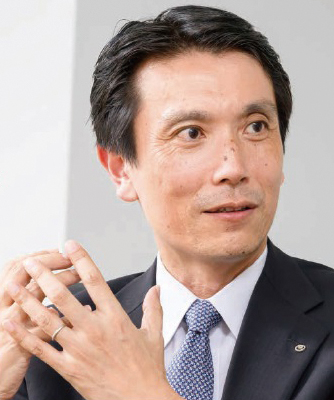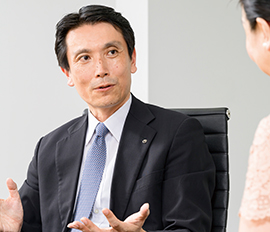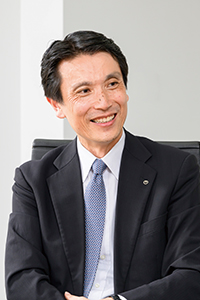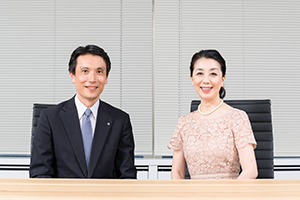 |
|||
|
|
|||
|
View from the Top Vol. 22, No. 9, pp. 1–5, Sept. 2024. https://doi.org/10.53829/ntr202409tp1
Becoming an Organization of Intuition by Being Exposed to a Shower of Peripheral Information from the Frontlines and MarketAbstractThe NTT Group is committed to solving social issues as a leading corporate group in the telecommunications business with a public responsibility. Its goal is to create a well-being society by building the world’s most-advanced and sustainable social systems and infrastructures. We interviewed Kei Ikeda, NTT senior vice president, head of technology planning, who also serves as the co-chief artificial intelligence officer and chief information officer, about the NTT Group’s technology strategies and his beliefs as a top executive. Keywords: intuition, peripheral information, IOWN, green transformation Promote implementation of new technologies in-house and confidently propose our accumulated results and expertise—What is the main role that the Technology Planning Department plays in the NTT Group’s technology strategies? Resolving social issues is the mission of the NTT Group, and the mission of the Technology Planning Department is to formulate technology strategies and incorporate them into the business operations of our operating companies. When talking about NTT technology, some people may think of our research laboratories, but the laboratories and the Research and Development Planning Department that oversees them are engaged in research themes ranging from basic research to practical application of future-oriented technologies. The Technology Planning Department formulates strategies for developing and introducing new technologies in the market as well as our laboratories’ technologies for NTT’s overall network and information technology systems; implements such technologies at each NTT Group company; and refines and introduces the technologies into society by using the peripheral information possessed by our operating companies’ employees. Our front-line employees are exposed to a shower of peripheral information and accumulate experience and expertise, which enables us to hone our technologies to the point at which we can confidently propose to customers and thereby help solve their problems.
Making IOWN truly marketable—You mentioned “a shower of peripheral information.” What does that phrase mean? My frequent use of the term “shower of peripheral information” was inspired by the book, “The Structure of Intuition” [1], written by Masakazu Nakayama, a former researcher of the Nippon Telegraph and Telephone Public Corporation. The book explains human’s senses and intuition from the viewpoint of cerebral physiology held at the time. To summarize the book’s point in simple terms, there are tens of thousands of times more information on the periphery of the information we want to know, and we absorb it without even knowing it. We also have a mechanism that suppresses the information unconsciously absorbed and stored so that it does not overflow uncontrollably, but the information that overrides this mechanism leads to so-called intuition. In other words, when a person is curious and working on a wide range of things, it may not make sense at the time, but if they are consciously thinking about a problem in the first person, those things will combine and be expressed as a meaningful intuition. I believe this is a great strength that humans possess. If the various peripheral information possessed by individual employees in an organization could be bundled together, and if those individuals share the same awareness of a problem and work together, the organization evolves into one that has instinct. The shower of peripheral information is the very source of this intuition. The Technology Planning Department plays a central role in formulating the NTT Group’s technology strategies, and we conduct our daily work while aiming to be this ideal organization with intuition. With this vision of an organization and sense of mission in mind, we are pursuing the widespread use of NTT’s Innovative Optical and Wireless Network (IOWN) as well as strengthening of our networks to counter communication failures and natural disasters by using a shower of peripheral information.
—The APN (All-Photonics Network) IOWN1.0 service has been launched. Can you tell us about the importance of a shower of peripheral information in spreading IOWN? Also, how are your efforts to create a circular economy society going? Simply put, the aim of IOWN is to apply the optical technology that has been cultivated in the world of telecommunications to the world of computers (signal processing) and bring ultra-low-power-consumption servers to the market. Devices used in current computers, such as central processing units (CPUs), graphics processing units (GPUs), and memory, operate using electrical signals, and these devices communicate with each other using electrical signals. By replacing the electrical signals with optical signals, we aim to significantly reduce power consumption. The key to achieving this is photonics-electronics convergence devices, which requires software called a network operation system (NOS). Against this background, in December 2023, NTT agreed to invest in ACCESS Co., Ltd., which is a parent company of IP Infusion that develops OcNos, the highly evaluated NOS in the global market. One of the advantages of investing in ACCESS was that we are now able to draw a development roadmap in conjunction with marketers who are active at the forefront of the global market. There is a great benefit of having NTT researchers directly access information on the frontlines of the market, that is, being exposed to a shower of peripheral information. Although we received harsh comments such as “the market doesn’t want that kind of functionality,” we have been able to form solutions that those global marketers say will sell. We are currently preparing for the first release of the network solutions. As IOWN advances from the concept stage to implementation, we will strive to make IOWN truly marketable by receiving a shower of peripheral information. The NTT Group announced its environment and energy vision “NTT Green Innovation toward 2040” in 2021, declaring to achieve carbon neutrality by FY2040 by reducing approximately half of its carbon dioxide (CO2) emissions with IOWN and reducing the remaining half by increasing the use of renewable energy sources. In line with this vision, NTT Anode Energy acquired the wind-power generation company Green Power Investment Corporation (GPI) in 2023. GPI has the capacity to generate two-million kW of renewable energy (equivalent to power generated by two nuclear power units), including those under development. With this acquisition, we have almost secured the renewable energy we need within the NTT Group. Going forward, we plan to supply renewable energy to customers outside the NTT Group. Renewable energy is, however, highly unstable and requires the capability of balancing supply and demand of electricity. In response to this requirement, NTT Anode Energy is working on stabilizing an electricity grid by combining an energy-management system that uses the latest information and communication technology of the NTT Group and storage batteries. I also believe that we can contribute to the local production for local consumption of renewable energy through IOWN initiatives that I mentioned earlier. If technology can be established to link computer devices by using optical technology, for example, computing resources such as CPUs and GPUs in a datacenter in Hokkaido or Kyushu and storage in a datacenter in the Tokyo metropolitan area could be linked and operated as a single large computer. If the Kyushu area is sunny, computing resources in Kyushu can be used; conversely, if the Hokkaido area is sunny, computing resources in Hokkaido can be used. Through such utilization of resources, it becomes possible to match energy demand to fluctuating supply of renewable energy. To strengthen our efforts in the field of green transformation (GX), we have launched a group-wide brand “NTT G×Inno (pronounced ‘geeno’).” G×Inno stands for “GX times Innovation” and expresses our desire to create innovation in the GX field and contribute to achieving Japan’s goal of carbon neutrality by 2050. We will first decarbonize the NTT Group and our value chains. We will then propose GX solutions that leverage the expertise and achievements gained from these efforts to corporate customers, local governments, and other parties to contribute to achieving carbon neutrality throughout society. We aim to grow our business in the GX field and achieve over one trillion yen in sales by FY2030. IOWN and GX will play a critical role in maintaining the irreplaceable global environment. Although we face many challenges ahead, we will continue to promote IOWN and GX initiatives while being motivated by the desire to preserve the global environment.
The source of the NTT Group’s strength is the collective power of our employees—Connectivity is a lifeline of our lives. What kind of measures are you taking against communication failures and natural disasters and to enhance network resiliency? I had only been in the Technology Planning Department for little more than a week when another company experienced a major communication failure. This was not someone else’s problem, and just as we were starting to consider countermeasures within the NTT Group, NTT WEST caused a large-scale communication failure. This incident prompted us to establish the System Failure Recurrence Prevention Committee consisting of chief technology officers, chief digital officers, and other executives from NTT operating companies, and the committee began investigating ways to create a more resilient network that would prevent such incidents from occurring or enable quick recovery if they did occur. However, even after the establishment of the committee, large-scale communication failures continued to occur one after another at our operating companies. In response to this situation, in addition to implementing our existing measures of conducting a comprehensive group-wide review of the apparent risks, we have embarked on measures to further improve reliability on the premise that unforeseen events are bound to occur no matter how many measures we implement to prevent recurrence. For example, we assumed extreme, abnormal circumstances that would not normally occur, such as two-thirds of the equipment suddenly going down or three times the amount of traffic flowing in, and we asked each company to estimate what kind of impact such circumstances would have on their services. Through this activity, I was very encouraged by the fact that the answer to this difficult problem was found within the NTT Group. For example, the initiatives of one company were applied to address certain issues, while those of another company were applied to address other issues; in this way, a robust network was created throughout the NTT Group. Each operating company is exposed to different showers of peripheral information and seeks solutions on the basis of that information. The holding company is responsible for creating an organization that can generate new intuition by combining these intuitions in each company and rolling it out across the NTT Group. —What is important to you as a top executive? What is your message to researchers, engineers, and customers? To take advantage of the shower of peripheral information, I practice a bottom-up management style rather than a top-down approach. I believe that the source of the NTT Group’s strength lies in how it brings together the information possessed by each individual. The NTT Group can become a stronger organization if we can collect knowledge and share it effectively even under the governance with some centrifugal force. I joined NTT in 1992 as an engineer with the goal of becoming a specialist. However, I ended up somewhat of a generalist, and I even worked in the Human Resources Department at NTT EAST. Since I had more opportunities to meet with young employees through training work, I began to understand the organization as a whole. I was attracted to work in the field, and after consulting with my boss at the time, I was transferred to the Plant Department of a branch office. At that workplace, I witnessed highly motivated senior colleagues. I was impressed by those who had developed their skills while being exposed to a shower of peripheral information in the field, who worked with pride at being promoted to the Tokyo division, and who were acutely aware that they were the ones supporting the facilities in the field with their extensive expertise. I realized that the company was supported by people who were willing to work hard, and I was convinced that the company would be stronger if we can mobilize people with this kind of spirit. When I served as the head of the Plant Department at a branch office and branch manager, I visited the frontline at least once a week to receive showers of peripheral information. This experience made me think about how to increase the psychological safety of our employees—without putting up walls—so that they can provide us with peripheral information without hesitation. Last but not least, to engineers and researchers, let us keep in mind how our frontline employees, customers, and the market view our technologies and achievements, and hone our intuitions by interacting with such people and receiving a shower of peripheral information. I would also like to ask our customers and business partners to give us your honest opinions about the activities of our researchers and engineers. Receiving a shower of peripheral information from all of you sharpens our intuition and sensibilities. We will do our utmost to contribute to all your businesses through the technology we have refined in this way. Reference
Interviewee profileCareer highlightsKei Ikeda joined Nippon Telegraph and Telephone Corporation in 1992. In his career at NTT EAST, he served as the director of the Plant Department of Kanagawa Branch in 2012, the director of the Chiba Division in 2017, and the deputy director of the Network Business Headquarters in 2020. He has been in his current position since June 2022. |
|||












